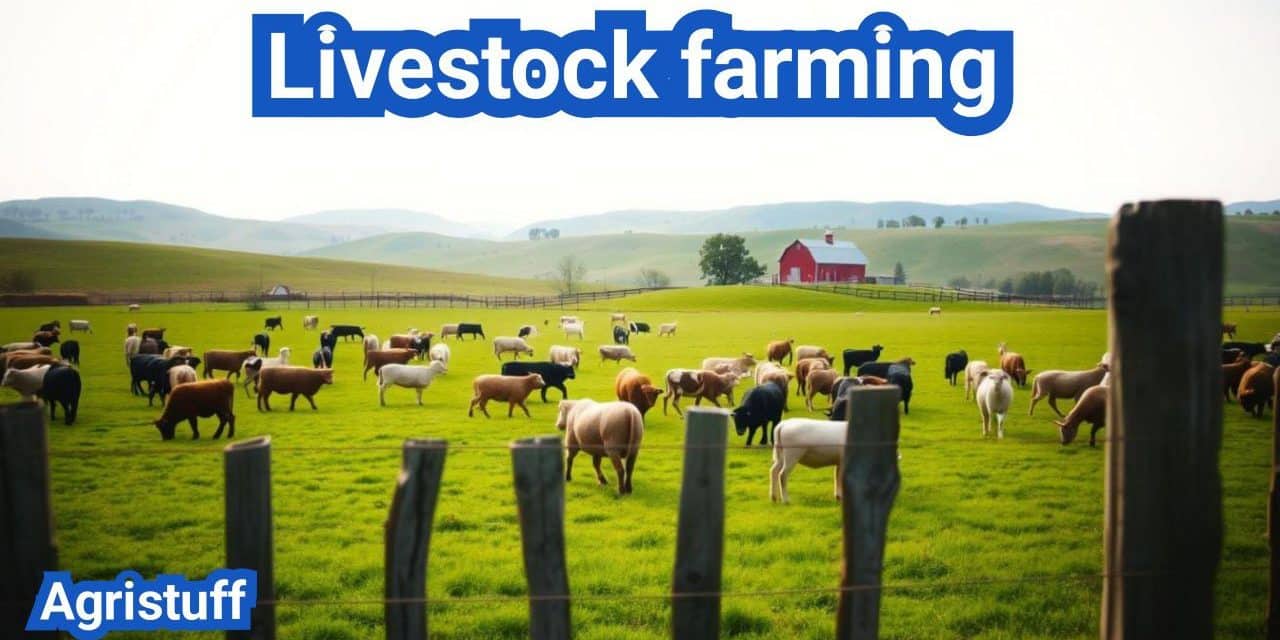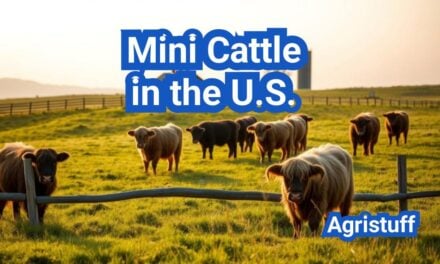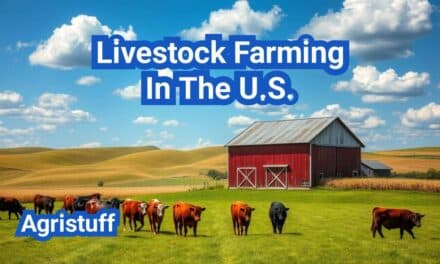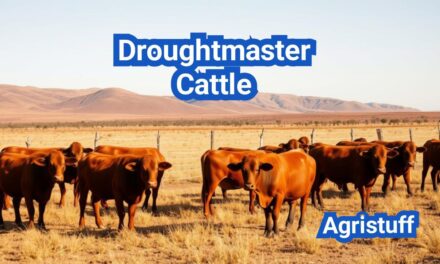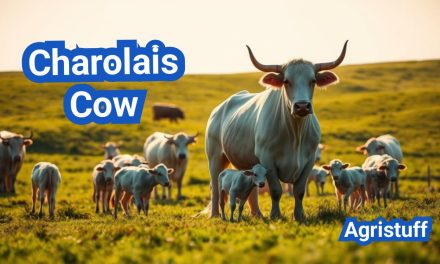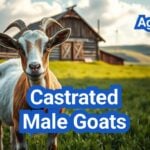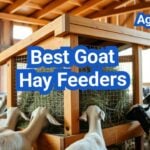Livestock farming refers to the practice of raising animals for food, fiber, and other products. It is a vital sector that contributes significantly to the economy and food security.
The history of animal husbandry dates back thousands of years, with various cultures developing unique methods and breeds. Today, sustainable farming practices are becoming increasingly important as the world focuses on environmental conservation and food sustainability.
Livestock farming encompasses a range of activities, including cattle, sheep, and goat farming, each with its specific practices and requirements.
Key Takeaways
- Livestock farming is crucial for food security and the economy.
- It involves raising animals for various products like food and fiber.
- Sustainable farming practices are gaining importance.
- Different types of livestock farming include cattle, sheep, and goat farming.
- The history of animal husbandry is rich and diverse.
What is Livestock Farming: Definition and Importance
With roots tracing back to around 10,000 years ago, livestock farming has been a cornerstone of human civilization. It involves the practice of raising animals for various products such as meat, dairy, wool, and more.
Core Concepts of Animal Husbandry
Animal husbandry, a crucial aspect of livestock farming, encompasses the care, management, and breeding of animals. It requires a deep understanding of animal behavior, nutrition, and health to ensure the well-being of the livestock farming and the quality of the products they provide.
Efficient animal husbandry practices involve providing appropriate shelter, nutrition, and healthcare to the animals. This not only improves the productivity of the farm but also ensures the humane treatment of the animals.
Historical Evolution of Livestock Practices
Livestock farming has undergone significant transformations over the centuries. From nomadic herding to modern intensive Livestock farming, the practices have evolved in response to technological advancements, societal needs, and environmental considerations.
The domestication of animals marked the beginning of livestock farming. Over time, farmers developed techniques to breed animals for desirable traits, leading to the diverse range of livestock breeds we see today.
Economic Impact in Modern Agriculture
Livestock farming plays a vital role in the economy of many countries, contributing to employment, income, and food security. The economic impact of livestock farming extends beyond the farm, influencing related industries such as feed production, veterinary services, and meat processing.
The livestock farming industry is also a significant exporter of goods, generating foreign exchange earnings for many nations. Moreover, it provides a livelihood for millions of people worldwide, from farmers to those employed in ancillary services.
Types of Livestock Farming Systems

Understanding the various types of livestock farming systems is crucial for agricultural success. Livestock farming is a diverse field, encompassing a range of practices from intensive, high-tech operations to extensive, pastoral systems.
Intensive Farming Methods
Intensive livestock farming methods involve raising livestock in high-density conditions, often with advanced technology to maximize efficiency and productivity. This approach is commonly used for poultry and swine production.
Advantages: Higher yield per acre, reduced land use, and potentially lower costs due to economies of scale.
Disadvantages: Increased risk of disease, higher resource input, and potential environmental impact.
Extensive and Pastoral Systems
Extensive and pastoral systems involve grazing livestock over large areas, often with minimal external inputs. This method is commonly used for cattle and sheep farming.
Advantages: Lower initial investment, potentially lower environmental impact, and better animal welfare.
Disadvantages: Requires large land areas, can be vulnerable to climate and weather fluctuations.
| System | Land Use | Initial Investment | Environmental Impact |
|---|---|---|---|
| Intensive | Low | High | High |
| Extensive | High | Low | Low |
| Mixed Crop and Livestock | Medium | Medium | Medium |
Mixed Crop and Livestock Operations
Mixed crop and livestock farming operations integrate both crop production and livestock raising on the same farm. This approach can enhance biodiversity and improve resource use efficiency.
Advantages: Diversified income streams, improved soil fertility, and reduced pest and disease pressure.
Disadvantages: Requires diverse skill sets, can be complex to manage.
Specialized Production Systems
Specialized production systems focus on a specific type of livestock farming or product, such as dairy or beef cattle. These systems often benefit from economies of scale and specialized knowledge.
Advantages: Expertise in a specific area, potential for higher efficiency and productivity.
Disadvantages: Vulnerability to market fluctuations, potential for overspecialization.
How to Start Your Livestock Farming Operation
Launching a livestock farming operation involves a multi-faceted approach that includes evaluating your land, navigating legal requirements, and developing a robust business strategy. To ensure success, it’s crucial to carefully consider each of these elements.
Assessing Land and Infrastructure Requirements
The first step in starting a livestock farm is assessing your land and infrastructure. This involves evaluating the quality of your pasture, the availability of water, and the condition of your fencing. Adequate land preparation is crucial for the health and productivity of your livestock.
When assessing your land, consider factors such as soil quality, drainage, and the presence of any toxic plants. It’s also essential to evaluate the existing infrastructure, including barns, fencing, and watering systems. Investing in proper infrastructure can significantly reduce long-term costs and improve animal welfare.
| Land Assessment Criteria | Importance | Action Required |
|---|---|---|
| Soil Quality | High | Conduct soil testing to determine nutrient levels and pH |
| Fencing Condition | High | Inspect and repair or replace fencing as necessary |
| Water Availability | Critical | Ensure access to clean, reliable water sources |
Navigating Legal Considerations and Permits | Livestock Farming
Understanding and complying with legal requirements is a critical aspect of starting a livestock farm. This includes obtaining necessary permits, adhering to zoning regulations, and complying with environmental standards. Failure to comply with these regulations can result in significant fines or even the closure of your operation.
It’s advisable to consult with local authorities and agricultural experts to ensure you have all the necessary permits and are in compliance with local, state, and federal regulations.
Developing a Comprehensive Business Plan | Livestock Farming
A well-crafted business plan is essential for the success of your livestock farming operation. This plan should outline your goals, production strategies, marketing approaches, and financial projections. A comprehensive business plan serves as a roadmap for your operation, helping you navigate challenges and capitalize on opportunities.
When developing your business plan, consider factors such as market demand, competition, and potential risks. It’s also crucial to establish clear financial projections, including startup costs, ongoing expenses, and revenue forecasts.
Calculating Initial Investment and Ongoing Costs | Livestock Farming
Calculating the initial investment and ongoing costs is vital for determining the financial viability of your livestock farming operation. This includes costs associated with land preparation, infrastructure, livestock purchase, and operational expenses. Accurate financial planning is crucial for securing funding and ensuring the long-term sustainability of your operation.
Consider creating a detailed budget that outlines all startup and ongoing costs, including feed, veterinary care, and equipment maintenance. This will help you identify areas where you can optimize expenses and improve profitability.
Cattle Farming: Setup and Daily Management

Effective cattle farming demands a comprehensive approach, from initial setup to ongoing daily management. This multifaceted endeavor requires careful planning, attention to detail, and a deep understanding of cattle needs and behaviors.
Establishing Proper Facilities and Fencing
The foundation of a successful cattle farming operation lies in its facilities and fencing. Sturdy fencing is crucial for containing the cattle and protecting them from predators. The fencing should be designed to withstand various weather conditions and the cattle’s natural behaviors. Facilities such as barns, feeding areas, and watering systems must be designed with the cattle’s comfort and safety in mind, ensuring easy access to necessary resources.
Implementing Effective Grazing Systems
Grazing systems play a pivotal role in cattle farming, directly impacting the health of both the cattle and the land. Rotational grazing is a highly effective method that involves moving cattle to different grazing areas to prevent overgrazing and allow pastures to recover. This approach not only improves pasture quality but also enhances biodiversity and reduces the risk of parasites.
Daily Care Routines and Health Monitoring
Daily care routines are essential for maintaining the health and productivity of cattle. This includes regular feeding, ensuring access to clean water, and monitoring the cattle’s health. Farmers should be vigilant for signs of illness or distress, such as changes in appetite or behavior, and have a plan in place for addressing health issues promptly.
Safe Handling and Transportation Techniques
Safe handling and transportation of cattle are critical to prevent injury to both the animals and the handlers. Techniques such as moving cattle calmly and quietly, avoiding sudden movements, and using appropriate handling facilities can significantly reduce stress and the risk of injury. When transporting cattle, it’s essential to ensure that vehicles are designed for cattle transport and that the animals are securely contained to prevent injury during transit.
Beef Cattle Breeds and Selection
Understanding the different types of beef cattle breeds is essential for making informed decisions in livestock farming. The choice of breed can significantly impact the productivity, profitability, and sustainability of your farming operation.
Angus Cows: Characteristics and Production Benefits
Angus cattle are renowned for their high-quality beef and are one of the most popular breeds in the world. Their marbling ability and growth rate make them highly sought after. Key characteristics include:
- High marbling score, resulting in tender and flavorful meat
- Rapid growth rate, reaching market weight quickly
- Adaptability to various farming systems
Brahman Cattle: Heat Tolerance and Adaptability
Brahman cattle are known for their heat tolerance and adaptability to challenging environmental conditions. They are often used in crossbreeding programs to improve the hardiness of other breeds. Notable features include:
- Exceptional heat tolerance, making them suitable for hot climates
- Resistance to insects and diseases
- Strong maternal instincts and fertility
Simmental and Brangus: Growth and Meat Quality
Simmental cattle and Brangus cattle are recognized for their rapid growth and high-quality meat production. Simmentals are known for their muscular development, while Brangus combines the hardiness of Brahman with the growth characteristics of Angus. Key benefits include:
- Rapid growth rates and efficient feed conversion
- High-quality beef with good marbling
- Improved fertility and longevity
Mini Cattle Breeds for Limited Acreage
For farmers with limited land, mini cattle breeds offer a viable option. These breeds retain the desirable characteristics of their full-sized counterparts but require less space and feed. Popular mini breeds include:
- Miniature Angus and Hereford
- Jersey and Dexter cattle
- Low maintenance requirements
Selecting the right beef cattle breed involves considering factors such as climate, available land, market demand, and production goals. By understanding the characteristics and benefits of different breeds, farmers can make informed decisions to optimize their livestock operations.
Dairy Cattle Farming Techniques

Effective dairy cattle farming requires a deep understanding of cattle breeds, milking systems, and milk handling practices. Dairy farming involves raising cattle specifically for milk production, and different breeds offer unique benefits and challenges.
Jersey Breed Cows: Efficient Milk Production
The Jersey breed is renowned for its high milk production and rich milk quality. Originating from the Channel Island of Jersey, these cows are known for their efficient milk production, with high butterfat content making their milk ideal for cheese production. Jersey cows are relatively small in size, which makes them suitable for smaller dairy farms.
Brown Swiss Cows: Longevity and Versatility
Brown Swiss cows are another popular breed in dairy farming, known for their longevity and versatility. They have a robust constitution and can thrive in various climates, making them a favorite among dairy farmers worldwide. Their milk is rich in protein and is suitable for a variety of dairy products.
Dexter Cows for Small-Scale Dairy Operations
For small-scale dairy operations, Dexter cows are an excellent choice. They are one of the smallest cattle breeds and are known for their hardiness and ease of handling. Dexter cows produce rich milk that is perfect for butter and cheese making, and their small size makes them ideal for farms with limited space.
Modern Milking Systems and Milk Handling
The advent of modern milking systems has revolutionized dairy farming. Automated milking machines not only increase efficiency but also reduce labor costs. Proper milk handling practices are crucial to maintain milk quality. This includes immediate cooling of milk, regular cleaning of milking equipment, and sanitary practices to prevent bacterial contamination.
In conclusion, successful dairy cattle farming hinges on the selection of the right cattle breed and the implementation of efficient milking and milk handling practices. By understanding the characteristics of different breeds and leveraging modern technology, dairy farmers can improve milk production and quality.
Goat Farming: A Step-by-Step Guide

With its potential for producing meat, milk, and other products, goat farming has become an attractive choice for many farmers. Goat farming involves raising goats for various purposes, requiring careful planning and management.
Setting Up Proper Housing and Facilities
Establishing appropriate housing and facilities is crucial for the success of a goat farming operation. This includes:
- Constructing secure and well-ventilated shelters to protect goats from harsh weather conditions.
- Creating fenced areas that prevent escape and predator entry.
- Providing adequate space for movement and grazing.
Implementing Daily Care and Management Practices
Effective daily care and management are vital for maintaining the health and productivity of goats. Key practices include:
- Monitoring the health of goats daily, looking for signs of illness or distress.
- Providing a balanced diet that meets nutritional needs.
- Ensuring access to clean water at all times.
Regular health checks are essential to prevent disease outbreaks, and proper nutrition is critical for optimal growth and production.
Goat Rearing for Different Purposes
Goats can be raised for various purposes, including meat, milk, and fiber production. The purpose of rearing will influence the breed selection, management practices, and marketing strategies.
- For meat production, breeds like the Boer goat are popular.
- For dairy purposes, breeds such as the Saanen goat are favored.
- For fiber production, Angora goats are the primary choice.
Mini and Pygmy Goat Varieties for Small Farms

Mini and pygmy goat breeds have gained popularity among small-scale farmers due to their compact size and versatile uses. These goats are not only manageable on small farms but also provide a range of products and benefits.
Nigerian Mini and Pygmy Goats: Care and Characteristics
Nigerian pygmy goats are known for their small stature and friendly disposition, making them an excellent choice for small farms. They require less space and feed compared to larger breeds, and their care involves regular health checks, vaccinations, and a balanced diet.
These goats are also versatile, providing milk, meat, and even serving as companions or pets. Their small size makes them easier to handle, especially for beginners in goat farming.
African and Norwegian Pygmy Varieties: Features and Benefits
African pygmy goats are another popular variety, admired for their hardiness and adaptability to various climates. They are relatively low maintenance and can thrive on minimal land, making them suitable for small-scale farming operations.
Norwegian pygmy goats, while less common, offer unique characteristics that can be beneficial for specific farming goals, such as their ability to withstand colder climates. Both varieties are known for their agility and intelligence, traits that are advantageous in managing their grazing and overall care.
Space Requirements and Special Considerations
One of the key advantages of mini and pygmy goats is their minimal space requirement. However, it’s crucial to provide them with adequate fencing to prevent escape and ensure their safety. The fencing should be sturdy and tall enough to contain them, as goats are known for their ability to jump.
Additionally, providing shelter from extreme weather conditions is essential. A well-ventilated barn or shelter can protect them from harsh weather, ensuring their health and comfort.
Marketing Specialty Goat Products
Farmers can capitalize on the unique characteristics of mini and pygmy goats by marketing specialty products. Goat milk, for instance, is highly valued for its nutritional benefits and can be sold directly to consumers or used to produce cheese, soap, and other value-added products.
Moreover, the meat from these goats is considered a delicacy in some markets, offering another revenue stream. By focusing on niche markets and emphasizing the sustainable and humane aspects of their farming practices, farmers can differentiate their products and attract premium prices.
Sheep Breeding and Management Practices

The art of sheep breeding involves careful planning and execution to achieve desired outcomes in flock quality and productivity. Effective sheep breeding and management practices are crucial for the success of livestock farming operations.
Developing an Effective Breeding Program
A well-designed breeding program is the foundation of successful sheep breeding. It involves selecting superior genetics, managing breeding cycles, and maintaining accurate records. By focusing on traits such as fertility, growth rate, and disease resistance, farmers can improve their flock’s overall performance.
Managing Lambing Season Successfully
Lambing season is a critical period in sheep farming, requiring meticulous planning and attention to detail. Ensuring that ewes receive proper nutrition and care before, during, and after lambing is vital for the health of both the mother and the lambs. Effective management during this period can significantly impact the overall productivity of the flock.
Wool and Meat Production Fundamentals
Sheep are raised for both wool and meat production, each requiring different management strategies. For wool production, the focus is on breeds known for their high-quality fleece, while meat production emphasizes breeds with superior growth rates and carcass quality. Understanding the specific needs and characteristics of different breeds is essential for optimizing production.
Preventing and Addressing Common Health Issues
Maintaining the health of the flock is a top priority in sheep management. Common health issues include parasites, diseases, and nutritional deficiencies. Implementing preventive measures such as vaccination programs, parasite control, and nutritional management can help mitigate these risks and ensure the overall well-being of the flock.
Notable Sheep Breeds for Commercial Farming

In commercial sheep farming, the choice of breed is crucial for achieving desired outcomes in wool, meat, or milk production. Different breeds offer unique characteristics that can significantly impact the success and profitability of a farming operation.
Black Valais and Swiss Valais Sheep: Distinctive Features
The Black Valais and Swiss Valais sheep are known for their distinctive appearance and robust health. These breeds are prized for their high-quality wool and meat production capabilities. Originating from the Valais region, they are well-adapted to harsh mountainous environments, making them suitable for farms in similar conditions.
Jacob Sheep: Historical Significance and Characteristics
Jacob sheep are a multi-horned breed with historical significance and unique characteristics. They are often kept for their wool, meat, and as ornamental animals due to their striking appearance. Their ability to thrive in various environments makes them a versatile choice for commercial farming operations.
Shetland and Babydoll Southdown Varieties
Shetland sheep are renowned for their fine wool and hardiness, originating from the Shetland Islands. Babydoll Southdown sheep, on the other hand, are small in stature but are valued for their high-quality meat and friendly disposition. Both breeds are suitable for small to medium-scale commercial farming due to their manageable size and productive capabilities.
Goat Cross Sheep and Specialized Breeds
Some farms utilize crossbreeding programs, including goat cross sheep, to enhance certain traits such as hardiness or production efficiency. Specialized breeds are developed for specific purposes, such as improved wool or meat production. These breeding programs can offer farmers tailored solutions to meet their production goals and environmental conditions.
Advanced Livestock Feeding Strategies

Effective livestock feeding involves more than just providing food; it requires a comprehensive nutritional plan tailored to the specific needs of the animals. Advanced livestock feeding strategies are essential for optimizing animal health, improving productivity, and ensuring the overall profitability of the farm.
Nutritional Planning for Different Species
Formulating species-specific nutritional plans is a critical aspect of livestock feeding. Different species have unique nutritional requirements that must be met to ensure optimal health. For example, cattle require a diet rich in fiber, while poultry need high-protein feeds. Understanding these requirements is crucial for developing effective feeding strategies.
The nutritional needs of livestock can vary significantly depending on factors such as age, breed, and production level. For instance, lactating dairy cows require more energy and nutrients compared to dry cows. Similarly, growing animals need more protein to support their development.
Seasonal Adjustments for Optimal Health
Seasonal feeding adjustments are vital for maintaining the health and productivity of livestock. Changes in temperature, humidity, and availability of pasture can impact the nutritional needs of animals. For example, during hot summer months, animals may require more water and electrolytes to stay hydrated.
In regions with cold winters, livestock may need additional energy to maintain body heat. This can be achieved by adjusting their diet to include more high-energy feeds. Understanding these seasonal variations is key to implementing effective feeding strategies.
Supplementation Techniques and Best Practices
Supplementation is a common practice in livestock feeding to ensure that animals receive all necessary nutrients. This can include vitamins, minerals, and other additives to their feed. The key is to use supplementation techniques judiciously to avoid over-supplementation, which can be harmful.
Best practices in supplementation involve understanding the specific nutritional gaps in the diet of the animals and addressing them accordingly. Regular monitoring of animal health and performance can help in identifying the need for supplements.
Water Management for Livestock
Water management is a critical aspect of livestock feeding that is often overlooked. Access to clean, fresh water is essential for the health and productivity of animals. Different livestock have different water requirements; for example, lactating cows need more water compared to dry cows.
| Livestock Type | Water Requirement (liters/day) |
|---|---|
| Cattle | 50-100 |
| Sheep/Goats | 5-10 |
| Poultry | 0.2-0.5 |
Implementing effective water management systems involves ensuring that water is always available and clean. Regular checks on water quality and quantity are necessary to maintain animal health.
Sustainable Livestock Farming Practices for the Future

The future of livestock farming hinges on adopting sustainable practices that not only reduce environmental degradation but also promote ecosystem health. As the global demand for meat and dairy products continues to rise, the need for sustainable livestock farming practices becomes increasingly important.
Minimizing Environmental Impact
Livestock farming can have significant environmental impacts, including deforestation, water pollution, and greenhouse gas emissions. To minimize these effects, farmers can adopt several strategies:
- Rotational Grazing: This practice involves moving livestock to different areas of pasture to avoid overgrazing and promote soil health.
- Manure Management: Proper handling and storage of manure can reduce nutrient runoff into waterways and minimize the risk of water pollution.
- Efficient Water Use: Implementing water-saving technologies and practices can help reduce the overall water footprint of livestock operations.
Implementing Regenerative Grazing Techniques
Regenerative grazing is a practice that focuses on improving soil health, biodiversity, and ecosystem services through careful management of grazing patterns. This approach can lead to:
- Increased Soil Carbon Sequestration: By promoting soil health, regenerative grazing can help sequester carbon from the atmosphere.
- Improved Biodiversity: Regenerative grazing practices can enhance habitat diversity and promote a wider range of plant and animal species.
- Enhanced Ecosystem Services: Healthy pastures can provide numerous ecosystem benefits, including improved water filtration and reduced erosion.
Developing Effective Waste Management Systems
Effective waste management is crucial for reducing the environmental impact of livestock farming. Strategies include:
- Composting: Turning manure into compost can provide a valuable nutrient-rich fertilizer while reducing waste.
- Anaerobic Digestion: This process involves breaking down organic matter in the absence of oxygen to produce biogas, which can be used as energy.
Adapting to Climate Change Challenges
Climate change poses significant challenges to livestock farming, including increased frequency of extreme weather events and changing temperature and precipitation patterns. To adapt, farmers can:
- Implement Climate-Resilient Practices: This includes strategies like adjusting grazing patterns and breeding programs to suit changing climate conditions.
- Enhance Soil Health: Improving soil health through regenerative practices can help mitigate some of the impacts of climate change.
By adopting these sustainable livestock farming practices, farmers can contribute to a more environmentally friendly and resilient agricultural system.
Building a Resilient and Profitable Livestock Operation
Building a resilient and profitable livestock operation requires careful planning, effective management, and a commitment to sustainability. By understanding the core concepts of animal husbandry, selecting appropriate breeds, and implementing advanced feeding strategies, farmers can establish a thriving livestock business.
Effective livestock management involves not only daily care routines but also adapting to climate change challenges and minimizing environmental impact. Regenerative grazing techniques, waste management systems, and seasonal feeding adjustments can contribute to a more sustainable operation.
A profitable livestock farming operation is built on a foundation of sound business planning, proper infrastructure, and a deep understanding of the chosen livestock species. By combining these elements, farmers can create a resilient livestock operation that thrives in an ever-changing agricultural landscape.
FAQ
What is livestock farming?
Livestock farming refers to the practice of raising animals for food, fiber, or other products. It involves the care, management, and breeding of animals such as cattle, sheep, goats.
What are the different types of livestock farming systems?
There are several types of livestock farming systems, including intensive, extensive, and mixed crop and livestock operations. Intensive systems involve confining animals to a small area, while extensive systems involve grazing animals on large areas of land. Mixed crop and livestock operations involve integrating livestock into crop production systems.
How do I start a livestock farming operation?
To start a livestock farming operation, you need to assess your land and infrastructure, navigate legal considerations and permits, develop a comprehensive business plan, and calculate your initial investment and ongoing costs.
What are the most common livestock breeds in the USA?
Some of the most common livestock breeds in the USA include Angus, Brahman, and Simmental cattle, as well as sheep breeds like Black Valais and Jacob sheep.
What are the benefits of sustainable livestock farming practices?
Sustainable livestock farming practices can help minimize environmental impact, improve animal welfare, and increase profitability. Techniques like regenerative grazing, waste management, and climate change adaptation can help achieve these benefits.
How do I manage livestock feeding and nutrition?
Livestock feeding and nutrition involve formulating species-specific nutritional plans, making seasonal feeding adjustments, and using supplementation techniques. Water management is also crucial for maintaining animal health.
What are the key considerations for cattle farming?
Cattle farming involves establishing proper facilities and fencing, implementing effective grazing systems, and providing daily care routines and health monitoring. Safe handling and transportation techniques are also essential.
What are the benefits of raising mini and pygmy goats?
Raising mini and pygmy goats can be a profitable venture, especially for small farms. These breeds require less space and feed, and can be marketed for their specialty products, such as meat, milk, or fiber.
How do I develop an effective breeding program for sheep?
Developing an effective breeding program for sheep involves selecting breeds suitable for your climate and production goals, managing lambing season successfully, and implementing wool and meat production fundamentals.
What are the most notable sheep breeds for commercial farming?
Some of the most notable sheep breeds for commercial farming include Black Valais, Jacob, Shetland, and Babydoll Southdown sheep. These breeds offer distinctive features, historical significance, and production benefits.
How can I minimize the environmental impact of my livestock operation?
Minimizing environmental impact involves implementing regenerative grazing techniques, developing effective waste management systems, and adapting to climate change challenges. These practices can help reduce your operation’s ecological footprint.
Conclusion of: Livestock farming
Livestock farming is one of humanity’s oldest agricultural practices and remains an essential part of the global economy and food system. From cattle and sheep to poultry and pigs, livestock farming encompasses raising animals primarily for meat, milk, wool, and other products. The practice is not only critical for human nutrition but also supports countless economies worldwide.
What is Livestock Farming?
Livestock farming refers to the rearing of domesticated animals to produce commodities such as food, fiber, and labor. This type of agriculture has evolved significantly over the years, adapting to technological advancements, market demands, and sustainability concerns.
For detailed information, visit the Food and Agriculture Organization (FAO) website.
Importance of Livestock Farming
Livestock farming holds immense economic and nutritional significance globally. It provides employment opportunities, contributes substantially to the agricultural GDP, and ensures food security through a reliable supply of essential nutrients like protein and vitamins.
To understand more about the global impact, refer to this article by World Bank.
Types of Livestock Farming
There are several types of livestock farming practices adopted worldwide, including intensive farming, extensive farming, mixed farming, and pastoral farming. Each type is uniquely tailored to suit environmental conditions, available resources, and specific market demands.
Learn more about types of livestock farming from the USDA.
Livestock Breeds
Livestock farming involves various breeds of animals, each possessing unique characteristics suited for particular climates, terrains, and production goals. Examples include Holstein cows for dairy farming, Suffolk sheep for meat production, and Leghorn chickens for egg production.
Visit the American Livestock Breeds Conservancy for comprehensive breed information.
Best Practices in Livestock Farming
Efficient livestock farming practices are essential for sustainability, animal welfare, and profitability. Some best practices include proper nutrition, regular veterinary care, ethical handling, and strategic breeding programs.
For further guidelines, check the National Sustainable Agriculture Coalition.
Livestock Farming Equipment
Modern livestock farming relies heavily on advanced equipment and technology such as automated feeders, milking machines, tagging devices, and climate control systems. These tools increase efficiency, reduce labor costs, and improve overall productivity.
Explore equipment details at Farm Progress.
Challenges in Livestock Farming
Despite its numerous benefits, livestock farming faces significant challenges such as disease outbreaks, environmental impact concerns, fluctuating market prices, and regulatory compliance issues. Addressing these challenges requires ongoing research, innovation, and adaptation.
For insights into current challenges, consult National Geographic.
Environmental Impact and Sustainability
Livestock farming has profound implications for the environment, including land degradation, water pollution, and greenhouse gas emissions. However, sustainable livestock practices such as rotational grazing, manure management, and integrated farming can mitigate these impacts.
Read about sustainability strategies at WWF.
Future Trends in Livestock Farming
Innovations in biotechnology, precision agriculture, and sustainable practices are set to shape the future of livestock farming. Enhanced genetic selection, improved animal welfare protocols, and smart farming technologies are anticipated to drive productivity and sustainability.
Further reading can be found at AgTech Innovation.
Final Thought
Livestock farming remains an indispensable component of agriculture globally. Embracing sustainable practices and innovative technologies will ensure its ongoing viability and productivity, providing economic stability and food security for future generations.

